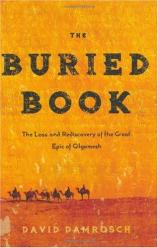The Buried Book: The Loss and Rediscovery of the Great Epic of Gilgamesh
Review
The Buried Book: The Loss and Rediscovery of the Great Epic of Gilgamesh
"The
Epic of Gilgamesh" is standard fare in college literature, history
and religion courses today. The ancient Mesopotamian tale, which
has the earliest known version of the Flood Story, has influenced
and inspired Mesopotamians (including the ancestors of the early
Hebrews) for centuries, along with possibly Greeks and other
Mediterranean peoples. However, but for a chance archaeological
discovery in the 19th century, the original tale may have been lost
forever.
In THE BURIED BOOK, scholar David Damrosch explores the importance
of Gilgamesh for the ancient Mesopotamians as well as how it was
discovered in the early days of archeology and translated from
cuneiform into English by a self-taught linguist.
The journey of the epic from ancient Mesopotamia to the college
classroom and beyond is quite extraordinary, and Damrosch does an
excellent job presenting the tale. He cleverly tells the story of
the "loss and rediscovery" of Gilgamesh backwards, starting with
its translation from the clay tablets by George Smith, who worked
for the British Museum, in 1872. Without Smith, Gilgamesh and his
story most likely would have been ignored or overlooked.
The actual discovery of the Gilgamesh tablets (no one entire copy
has survived, and what we read has been pieced together from
tablets at various sites) was made by the Iraqi archaeologist
Hormuzd Rassam, a figure who bridged the divide between the
Occident and the Orient. Despite his success and important
discoveries, he was never fully accepted or respected by most of
his European counterparts, even after making England his home and
years of dedicated service to the British Museum. Both Smith and
Rassam are as interesting as their work, and Damrosch nicely weaves
in to his book some of their biography.
Before Rassam uncovered the tablets that ultimately contained "The
Epic of Gilgamesh," they were buried for centuries. And, if not for
an Assyrian king in the 7th century BCE, the tablets may not have
survived at all. Ashurbanipal collected religious and secular
literary works, in effect creating the world's first library.
Ashurbanipal is also a fascinating character, and as THE BURIED
BOOK marches backward through time, Ashurbanipal's name is added to
the list of important men who preserved the amazing tale of
Gilgamesh. Gilgamesh himself predates anything written about him,
and Damrosch explores the history and legend of this very ancient
hero and leader.
After tracing the story of Gilgamesh back as far as possible,
Damrosch returns readers to the present. Saddam Hussein rushes to
put the finishing touches on his latest novel as American troops
close in on him. That he is a novelist may be surprising to some.
But at this point in Damrosch's examination, it is not surprising
that Hussein would compare himself to Gilgamesh and use the epic as
a cultural, national and religious touchstone. But Hussein is not
the only one to borrow from or refer to the great epic; writers
such as Philip Roth and, more recently, Joan London have done the
same. And, as Damrosch also explains, ancient authors most likely
have been doing so for well over a thousand years.
THE BURIED BOOK is smart and compelling, as much for the story of
the men who preserved the epic as for the story of the buried book
itself. It is an academic subject, but Damrosch's exploration is
immensely readable for lay people as well. Whether interested
in literature or history, culture or religion, readers will find
THE BURIED BOOK enjoyable and enlightening. The author has
succeeded in making what could have been a stuffy tale totally
exciting.
Reviewed by Sarah Rachel Egelman on January 6, 2011
The Buried Book: The Loss and Rediscovery of the Great Epic of Gilgamesh
- Publication Date: March 6, 2007
- Genres: History, Nonfiction
- Hardcover: 336 pages
- Publisher: Henry Holt and Co.
- ISBN-10: 0805080295
- ISBN-13: 9780805080292





